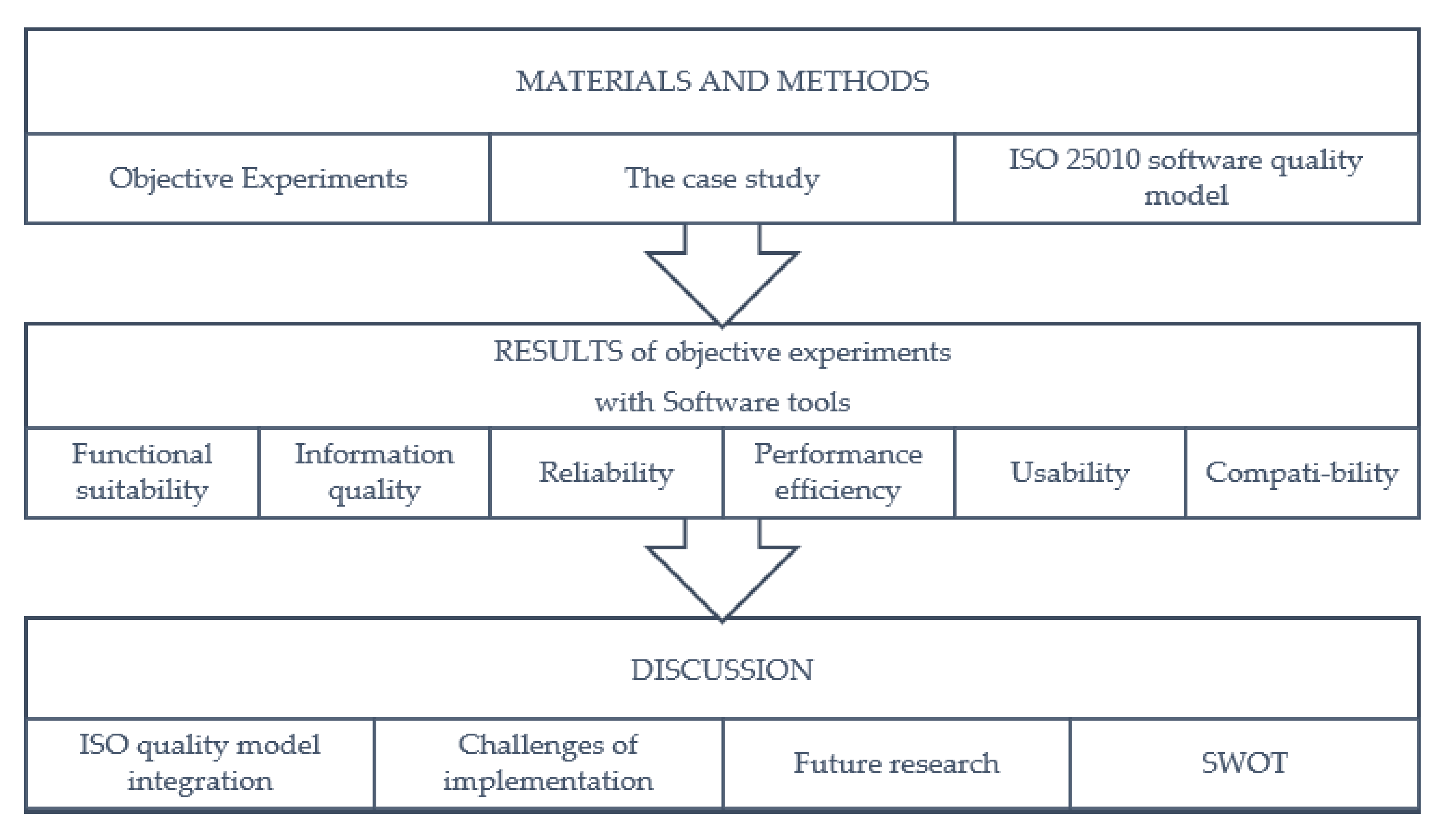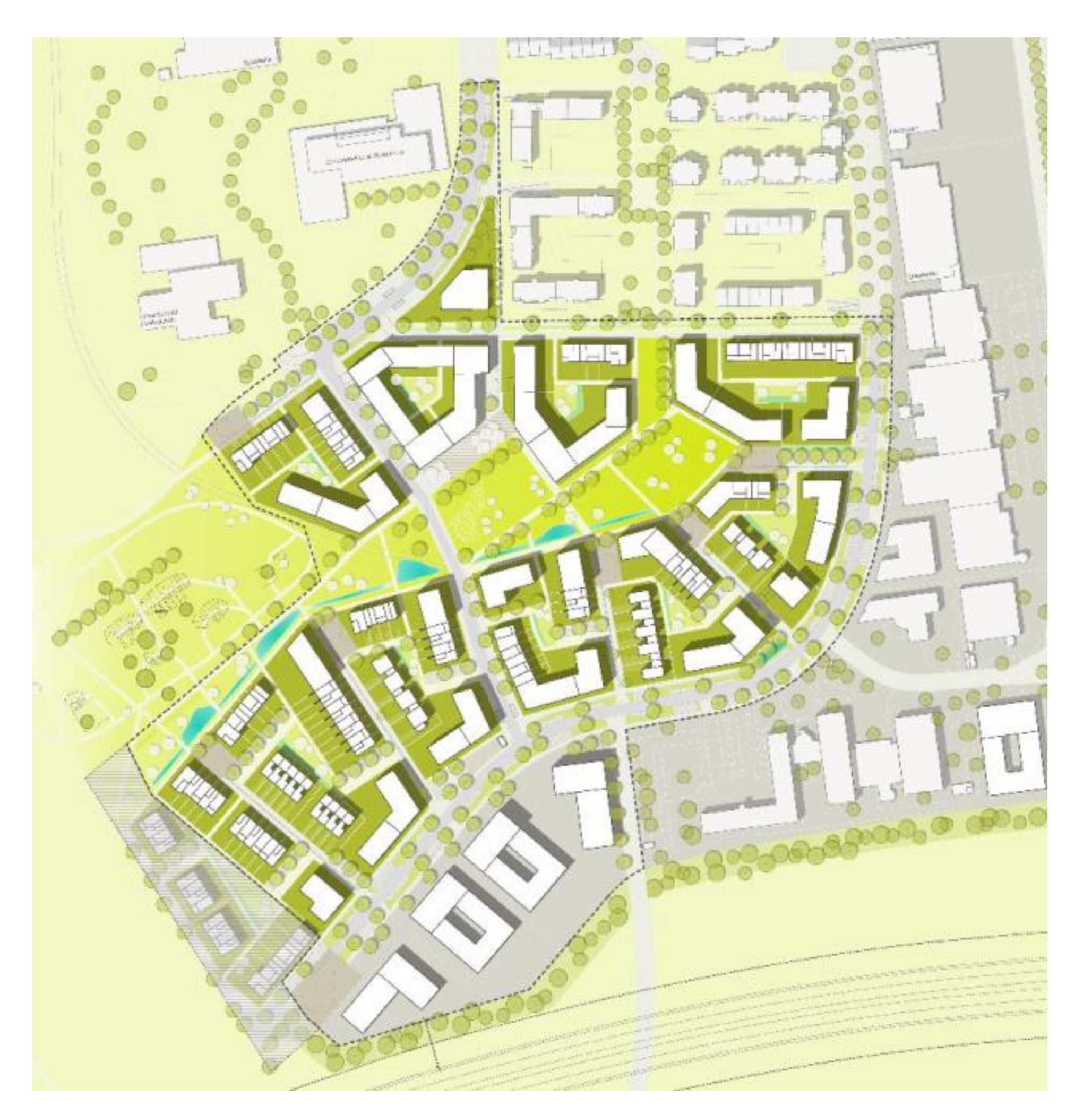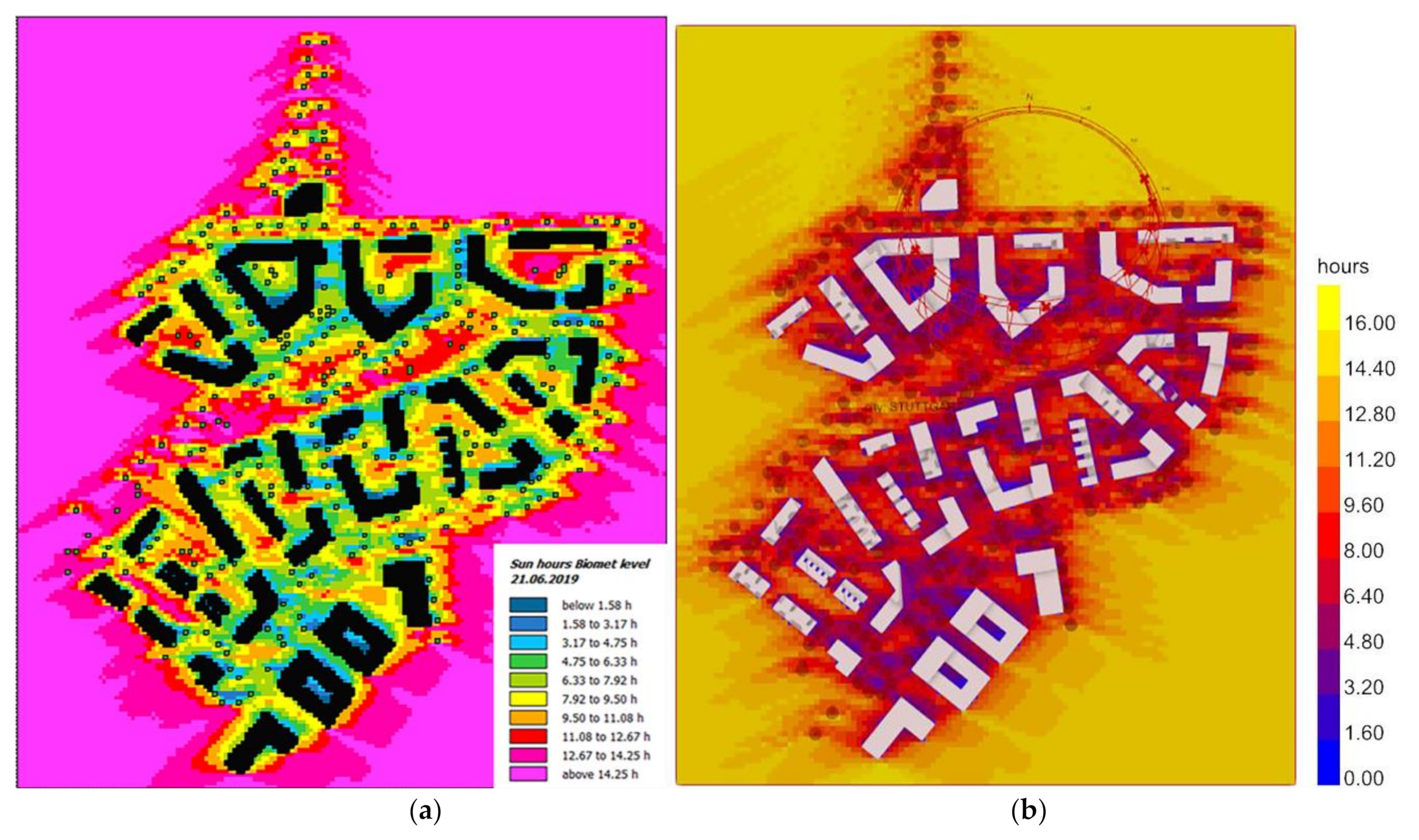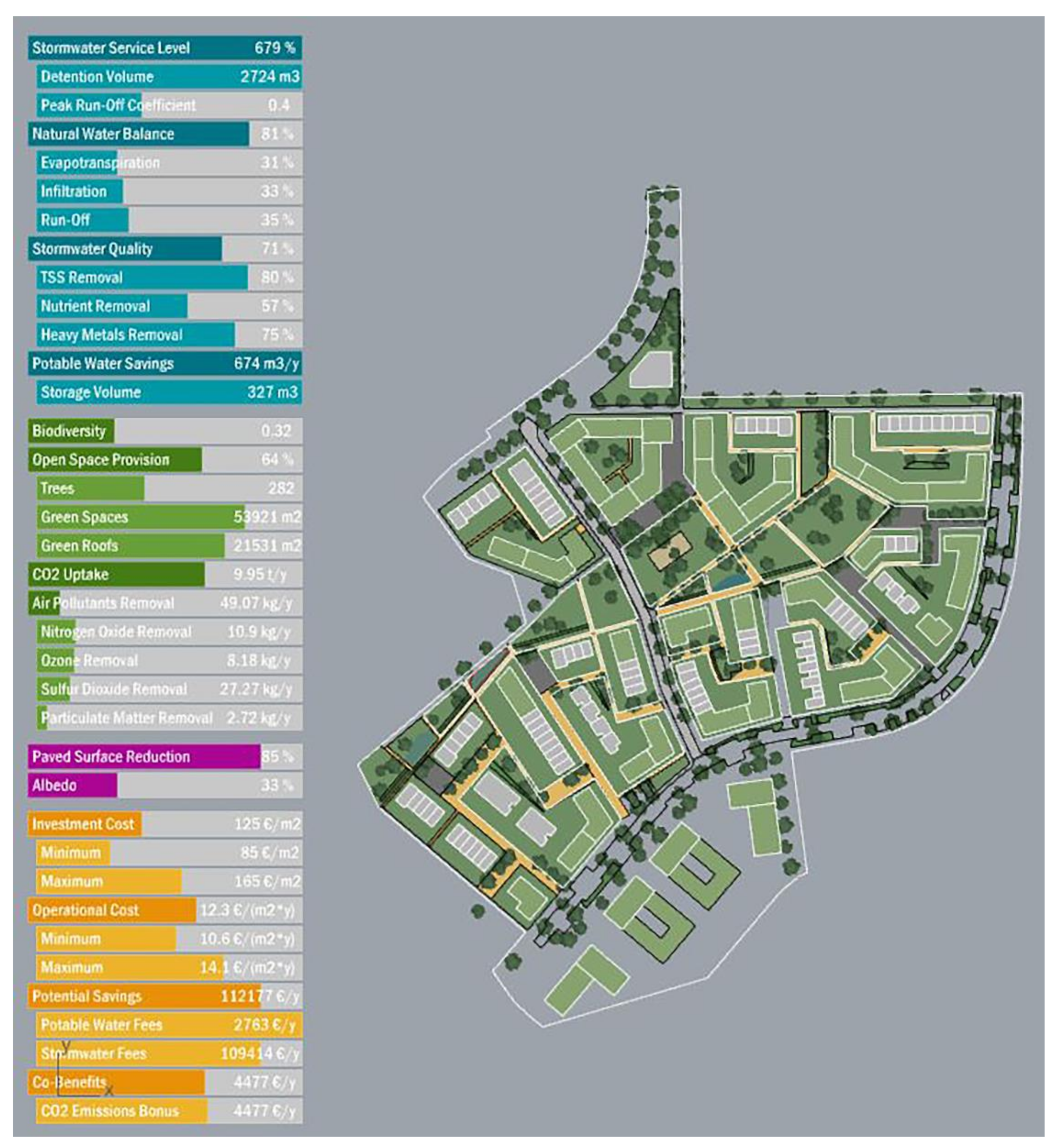BIM for Landscape Design Improving Climate Adaptation Planning: The Evaluation of Software Tools Based on the ISO 25010 Standard
Abstract
:1. Introduction
2. Materials and Methods
3. Results
3.1. Functional Suitability
3.1.1. Functional Completeness
3.1.2. Functional Appropriateness
3.1.3. Compliance with Sustainability Requirements
- -
- rainwater assessment;
- -
- site-specific flood risk assessment and management ensuring water run-off capabilities to deal with a 100-year flood event;
- -
- microclimate simulations illustrating the effect of urban morphology on air temperature, solar exposure, air movement, air pollution, and acoustics;
- -
- a climate adaptation plan considering the predicted climate change impact;
- -
- green infrastructure and high quality of open space;
- -
- ecological plans creating aesthetic value, ensuring social wellbeing, and adaptation to climate change.
- -
- floodplain avoidance;
- -
- rainwater management;
- -
- green infrastructure;
- -
- heat island reduction;
- -
- ecological services considering habitats and wetlands.
- -
- ecological qualities: climate change in the district and water and soil protection;
- -
- economic qualities: life cycle costs and economic effects on the community;
- -
- social-cultural qualities: environmental impacts;
- -
- technical qualities: rainwater management;
- -
- process qualities: participation.
3.2. Information Quality
3.2.1. Visual Information
3.2.2. Digital Information
3.3. Reliability
3.4. Performance Efficiency
3.5. Usability
3.6. Compatibility
3.7. Overview of Evaluation Results
3.8. Limitations of Results
4. Discussion
4.1. ISO Quality Model Evaluation for Software Tools
4.2. Challenges of the Implementation of Climate Adaptation Software
4.3. Future Research
4.4. SWOT
5. Conclusions
Author Contributions
Funding
Institutional Review Board Statement
Informed Consent Statement
Data Availability Statement
Acknowledgments
Conflicts of Interest
Nomenclature
| BIM | Building Information Modeling |
| BREEAM | Building Research Establishment Environmental Assessment Methodology; |
| DGNB | Deutsche Gesellschaft für Nachhaltiges Bauen (en. German Sustainable Building Council); |
| ISO | International Organization for Standardization; |
| LEED | Leadership in Energy and Environmental Design; |
| UTCI | Universal Thermal Climate Index |
References
- Explainer: Are Natural Disasters on the Rise? Available online: http://theconversation.com/explainer-are-natural-disasters-on-the-rise-39232 (accessed on 7 November 2021).
- Towards an EU Research and Innovation Policy Agenda for Nature-Based Solutions & Re-Naturing Cities Final Report of the Horizon 2020 Expert Group on Nature-Based Solutions and Re-Naturing Cities. Available online: https://op.europa.eu/en/publication-detail/-/publication/fb117980-d5aa-46df-8edc-af367cddc202 (accessed on 7 November 2021). [CrossRef]
- Ciscar, J.-C.; Iglesias, A.; Feyen, L.; Szabó, L.; Van Regemorter, D.; Amelung, B.; Nicholls, R.; Watkiss, P.; Christensen, O.B.; Dankers, R.; et al. Physical and economic consequences of climate change in Europe. Proc. Natl. Acad. Sci. USA 2011, 108, 2678–2683. [Google Scholar] [CrossRef] [PubMed] [Green Version]
- Intergovernmental Panel on Climate Change (IPCC). Climate Change 2014: Impacts, Adaptation and Vulnerability. Part A: Global and Sectoral Aspects. In Fifth Assessment Report of the Intergovernmental Panel on Climate Change; Cambridge University Press: Cambridge, UK; New York, NY, USA, 2014; Available online: https://www.ipcc.ch/report/ar5/wg2/ (accessed on 11 April 2021).
- Moser, S.C.; Ekstrom, J.A. A framework to diagnose barriers to climate change adaptation. Proc. Natl. Acad. Sci. USA 2010, 107, 22026–22031. [Google Scholar] [CrossRef] [PubMed] [Green Version]
- Associated General Contractors of America. The Contractor’s Guide to BIM, 1st ed.; AGC Research Foundation: Las Vegas, NV, USA, 2005. [Google Scholar]
- Ernst, C.; Blaha, K. Decision support tools for climate change planning. In The Trust for Public Land’s Climate-Smart Cities Program; San Francisco, CA, USA. 2016. Available online: https://www.tpl.org/decision-support-tools-climate-change-planning (accessed on 7 November 2021).
- Balogun, A.-L.; Marks, D.; Sharma, R.; Shekhar, H.; Balmes, C.; Maheng, D.; Arshad, A.; Salehi, P. Assessing the Potentials of Digitalization as a Tool for Climate Change Adaptation and Sustainable Development in Urban Centres. Sustain. Cities Soc. 2020, 53, 101888. [Google Scholar] [CrossRef]
- Lodico, M.G.; Spaulding, D.T.; Voegtle, K.H. Types of Approaches Used in Educational Research. In Methods in Educational Research: From Theory to Practice, 1st ed.; Jossey-Bass: San Francisco, CA, USA, 2006; Volume 1, pp. 10–21. [Google Scholar]
- Hasselbring, W.; Giesecke, S. Integration of Qualitative and Quantitative Methods. Res. Methods Softw. Eng. 2006, 1, 61–81. [Google Scholar]
- Easterbrook, S.; Singer, S.; Damian, D. Selecting Empirical Methods for Software Engineering Research. In Guide to Advanced Empirical Software Engineering; Shull, F., Singer, J., Sjøberg, D.I.K., Eds.; Springer: London, UK, 2008. [Google Scholar] [CrossRef]
- Zelkowitz, M.; Wallace, D. Experimental Models for Validating Technology. Comput. J. 1998, 31, 23–31. [Google Scholar] [CrossRef] [Green Version]
- BS ISO/IEC 25010:2011; Systems and Software Engineering —Systems and Software Quality Requirements and Evaluation (SQuaRE)—System and Software Quality Models. The British Standards Institution: London, UK, 2011. Available online: https://www.iso.org/obp/ui/#iso:std:iso-iec:25010:ed-1:v1:en (accessed on 8 January 2022).
- Lew, P.; Olsina, L.; Zhang, L. Quality, Quality in Use, Actual Usability and User Experience as Key Drivers for Web Application Evaluation. In Proceedings of the Web Engineering, 10th International Conference (ICWE 2010), Vienna, Austria, 5–9 July 2010; Benatallah, B., Casati, F., Kappel, G., Rossi, G., Eds.; LNCS 6189. Springer: Berlin/Heidelberg, Germany, 2010; pp. 218–232. [Google Scholar] [CrossRef] [Green Version]
- BREEAM. BREEAM Communities Technical Manual. BRE. 2017. Available online: https://www.breeam.com/communitiesmanual/#resources/otherformats/output/10_pdf/20_a4_pdf_screen/sd202_breeam_communities_1.2_screen.pdf (accessed on 7 November 2021).
- LEED. LEED v4 for Neighborhood Development. 2018. Available online: https://www.usgbc.org/resources/leed-v4-neighborhood-development-current-version (accessed on 7 November 2021).
- DGNB. DGNB Neubau Stadtquartiere (NSQ)—Kriterien. 2011. Available online: https://static.dgnb.de/fileadmin/dgnb-ev/de/_archiv/Aktuell/presseinfos/2011/111004_1A_Ausgezeichnete_Stadtquartiere_Kriterien.pdf (accessed on 7 November 2021).
- Ibrahim, Y.; Kershaw, T.; Shepherd, P. Improvement of the Ladybug-tools microclimate workflow: A verification study. In Proceedings of the Building Simulation and Optimization, Loughborough, UK, 9–10 September 2020. [Google Scholar]
- Wu, Z.; Chen, L. Optimizing the spatial arrangement of trees in residential neighborhoods for better cooling effects: Integrating modeling with in-situ measurements. Landsc. Urban Plan. 2017, 167, 463–472. [Google Scholar] [CrossRef]
- Liu, Z.; Zheng, S.; Zhao, L. Evaluation of the ENVI-Met Vegetation Model of Four Common Tree Species in a Subtropical Hot-Humid Area. Atmosphere 2018, 9, 198. [Google Scholar] [CrossRef] [Green Version]
- Scharf, B.; Kraus, F. Green Roofs and Greenpass. Buildings 2019, 9, 205. [Google Scholar] [CrossRef] [Green Version]
- Chatzinikolaou, E.; Chalkias, C.; Dimopoulou, E. Urban microclimate improvement using ENVI-Met climate model. ISPRS Int. Arch. Photogramm. Remote. Sens. Spat. Inf. Sci. 2018, XLII-4, 69–76. [Google Scholar] [CrossRef] [Green Version]
- Zheng, S.; Zhao, L.; Li, Q. Numerical simulation of the impact of different vegetation species on the outdoor thermal environment. Urban For. Urban Green. 2016, 18, 138–150. [Google Scholar] [CrossRef]
- Lee, H.; Mayer, H.; Chen, L. Contribution of trees and grasslands to the mitigation of human heat stress in a residential district of Freiburg, Southwest Germany. Landsc. Urban Plan. 2016, 148, 37–50. [Google Scholar] [CrossRef]
- El-Bardisy, W.M.; Fahmy, M.; El-Gohary, G.F. Climatic Sensitive Landscape Design: Towards a Better Microclimate through Plantation in Public Schools, Cairo, Egypt. Procedia Soc. Behav. Sci. 2016, 216, 206–216. [Google Scholar] [CrossRef] [Green Version]
- Morakinyo, T.E.; Lam, Y.F. Simulation study on the impact of tree-configuration, planting pattern and wind condition on street-canyon’s micro-climate and thermal comfort. Build. Environ. 2016, 103, 262–275. [Google Scholar] [CrossRef]
- Müller, N.; Kuttler, W.; Barlag, A.-B. Counteracting urban climate change: Adaptation measures and their effect on thermal comfort. Theor. Appl. Climatol. 2013, 115, 243–257. [Google Scholar] [CrossRef] [Green Version]
- Vidmar, J.; Roset, J. Evaluation of Simulation Tools for Assessment of Urban Form Based on Physical Performance; Faculty of Architecture: Ljubljana, Slovenia, 2013. [Google Scholar]
- Al-Bdour, M.; Baranyai, B. An overview of microclimate tools for predicting the thermal comfort, meteorological parameters and design strategies in outdoor spaces. Pollack Period. 2019, 14, 109–118. [Google Scholar] [CrossRef]
- Diéguez, A.P.; Duckart, C.; Coccolo, S. Urban Thermal Comfort Study. Available online: https://whitearkitekter.com/wp-content/uploads/2018/07/Thermal-Comfort-Analysis-Kiruna-White-Arkitekter.pdf (accessed on 7 November 2021).
- Fabbri, K.; Di Nunzio, A.; Gaspari, J.; Antonini, E.; Boeri, A. Outdoor Comfort: The ENVI-BUG tool to Evaluate PMV Values Output Comfort Point by Point. In Proceedings of the 8th International Conference on Sustainability in Energy and Buildings (SEB-16), Turin, Italy, 11–13 September 2016. [Google Scholar] [CrossRef]
- Ibrahim, Y.; Kershaw, T.; Shepherd, P. A methodology for Modelling Microclimates: A Ladybug-tools and ENVI-met verification study. In Proceedings of the 35th PLEA Conference. Planning Post Carbon Cities, Coruña, Spain, 1–3 September 2020. [Google Scholar]
- Naboni, E.; Meloni, M.; Coccolo, S.; Kaempf, J.; Scartezzini, J.L. An overview of simulation tools for predicting the mean radiant temperature in an outdoor space. In Proceedings of the CISBAT 2017 International Conference—Future Buildings & Districts—Energy Efficiency from Nano to Urban Scale (CISBAT 2017), Lausanne, Switzerland, 6–8 September 2017. [Google Scholar] [CrossRef]
- McEvoy, S. Planning Support Tools in Urban Adaptation Practice. Ph.D. Thesis, Delft University of Technology, Delft, The Netherlands, 2019. [Google Scholar] [CrossRef]







| ISO Requirements | Description | Targets | Measures |
|---|---|---|---|
| Functional Suitability | |||
| Functional completeness | Analysis of various aspects of climate adaptation covered in the software | Evaluation of the software’s functions | Observations |
| Functional appropriateness | Accomplishment of the task excludes unnecessary steps | Evaluation of process maps | Process maps and time register |
| Compliance with sustainability certifications | The analysis of the aspects of sustainability covered | Evaluation of the Software’s compliance with sustainability standards | Aspects defined in sustainability certifications |
| Information Quality | |||
| Accuracy | How accurate the simulations or calculations are | Evaluation of the accuracy of simulations | Visual and digital comparisons |
| Suitability | How the software informs on the climate adaptation performance | Evaluation of how the results inform on climate adaptation planning | Climate adaptation targets |
| Reliability | |||
| Software Availability | Evaluation of the software’s reliability | Calculation of incidents of the software ‘not responding’ | Incidents register |
| Fault tolerance | Evaluation of the software’s operation despite hardware or software faults | Calculation of errors and failures | Error register |
| Recoverability | Software can recover data in case of interruption | Evaluation of recovered data in case of system error | Observations |
| Performance efficiency | |||
| Time -behavior | Time needed for task processing and simulations | Calculation of time used per task | Time register |
| Resource utilisation | Resources needed for tasks (excludes productivity) | Evaluation of the resources (expert consultations, training material, other files and software tools) needed to perform the task | List of resources |
| Usability | |||
| Learnability | Time to learn to use the software for climate adaptation functions | Calculation of the time for training | Training time register |
| Operability | The software can be easily operated after having been learnt. | Evaluation of the software’s complexity | Observations |
| User error protection | Software can help users to avoid errors | Evaluation of error identification | Observations |
| Compatibility | |||
| Co-existence | Software performs efficiently, sharing a common environment and resources with other software tools | Evaluation of how the software is compatible with other software | Implementation process maps and time register |
| Interoperability | Software can exchange and use the information from other software | Evaluation of the data lost or geometrical issues in the exportation and importation | Observations |
| Parameter | ENVI-Met | Ladybug | CitySim | GreenScenario | AST |
|---|---|---|---|---|---|
| GREEN MEASURES | |||||
| Green factor | + | ||||
| Biodiversity | + | ||||
| Shaded area | + | + | + | ||
| BLUE MEASURES | |||||
| Rainwater management | + | + | |||
| Evapotranspiration | + | + | + | ||
| CLIMATE ANALYSIS | |||||
| Solar analysis | + | + | |||
| Surface temperature | + | + | |||
| Radiation | + | + | + | ||
| Air pollution | + | ||||
| Wind analysis | + | + | |||
| Thermal comfort | + | + | |||
| Thermal load | + | ||||
| Thermal storage | + | ||||
| Heat island reduction | + | + | + | ||
| CO2 reduction | + | + | |||
| ECONOMIC IMPACT | |||||
| Maintenance costs | + | + | |||
| Construction costs | + | + | |||
| 11p. | 6p. | 3p. | 8p. | 5p. |
| ENVI-Met | Ladybug | AST | GreenScenario | CitySim Pro | |
|---|---|---|---|---|---|
| Importation Compatibility | 1 Model Preparation using SketchUp INX Duration: 1 h 30 min | 1 Import SketchUp to Rhino Duration: 2 min | No compatibility | 1 Clean 3D model Duration: 20 min 2 Export to AutoCAD Duration: 3 min | 1 Export to AutoCAD; Duration: 2 min 2 Prepare DXF model Duration: 5 min |
| 2 Exportation to ENVI-met Spaces Duration: 5 min | 3 Export dwg to Rhino Duration: 2 min | 3 Import DXF into SIM Duration: 2 min | |||
| 3 Solving errors Duration: 2 h | |||||
| Model adjustments/ remodelling | 4 Adjustments in ENVI-met Spaces/Albero Duration: 1 h | 1 Assign the project location and boundary; Duration: 5 min 2 Define the characteristics of the area; Duration: 2 min 3 Define climate adaptation goals; Duration: 5 min 4 Choose climate adaptation measures; Duration: 2 min 5 Draw the measures on the map; Duration: 2 h 6 Generate the final design; Duration: 10 min | 4 Extrude the buildings and trees; Duration: 1 h 15 min 5 Assign materials to surfaces; Duration: 2 h 20 min | ||
| Settings | 5 Setting up the simulation Duration: 5 min | 2 Setting the Simulation 1 (visual scripting method) Duration: 45 min 3 Setting the Simulation 2 Duration: 30 min 4 Setting the Simulation 3 Duration: 30 min | - | 6 Prepare visual script; Duration: 15 min | 4 Prepare cli. and hor. Files; 5 Set up the attributes of materials; Duration: 5 min |
| Simulations | 6 Simulating Duration: 21 h | 5 Simulating Simulation 1 Duration: 2 min 6 Simulating Simulation 2 Duration: 2 min 7 Simulating Simulation 3 Duration: 2 min | - | 6 Simulation Duration: 98 h | |
| Results | 7 Illustration of simulation results Duration: 30 min | - | |||
| 8 Running BIOMET simulations (additional) Duration: 1 h 20 min | - | - | |||
| Overall Duration: 27 h 30 min Steps: 8 | Overall Duration: 2 h 23 min Steps: 7 (depends on the number of simulations) | Overall Duration: 2 h 24 min Steps: 6 | Overall Duration: 4 h 12 min Steps: 6 | Overall Duration: 98 h 14 min Steps: 6 |
| Requirement | ENVI-Met | Ladybug | CitySim | GreenScenario | AST |
|---|---|---|---|---|---|
| BREEAM | |||||
| Rainwater assessment | + | + | |||
| Flood risk assessment and management | + | ||||
| Microclimate analysis | + | + | + | ||
| Green infrastructure analysis | + | + | + | ||
| Ecological value analysis | + | + | |||
| LEED | |||||
| Floodplain analysis | + | + | |||
| Rainwater analysis | + | + | |||
| Green infrastructure analysis | + | + | + | ||
| Impact on heat island | + | + | + | ||
| Ecological analysis (habitats) | + | + | |||
| DGNB | |||||
| Climate change analysis | + | ||||
| Water and soil analysis | + | + | |||
| Life cycle costs | |||||
| Environmental impact | + | + | + | + | + |
| Rainwater management | + | + | |||
| 5p. | 3p. | 2p. | 10p. | 13p. |
| Measure | Surface | Storage Capacity (m3) | Return Time Factor (-) | Groundwater Recharge (mm/y) | Evapotrans-Poration (mm/y) | Heat Reduction (°C) | Cool Areas (-) | Construction | Maintenance |
|---|---|---|---|---|---|---|---|---|---|
| Adding trees to streetscape | 14,004.09 | 700 | 3.52 | 67 | 60 | 0.31 | 18 | 159,647 | 54 |
| Bioswale (with drainage) | 962.11 | 337 | 3.09 | 27 | 0 | 0.02 | 0 | 72,158 | 722 |
| Green roofs | 19,806 | 198 | 1.51 | 0 | 13 | 0.44 | 0 | 2,376,720 | 118,836 |
| Urban forest | 10,895.09 | 2179 | 12.6 | 27 | 30 | 0.24 | 2 | 10,895 | 545 |
| Permeable pavement systems (infiltration) | 7384.41 | 738 | 6.9 | 16 | 22 | 0 | 0 | 738,441 | 3101 |
| Rainwater detention pond (wet pond) | 435.08 | 131 | 3.08 | 13 | 0 | 0.01 | 0 | 17,403 | 87 |
| Quality Characteristics and Sub-Characteristics | ENVI-Met | GreenScenario | Ladybug | CitySim Pro | AST |
|---|---|---|---|---|---|
| Functional suitability | |||||
| Functional appropriateness | 1 | 4 | 2 | 3 | 5 |
| Functional completeness | 5 | 4 | 3 | 1 | 2 |
| Compliance with sustainability requirements | 3 | 4 | 2 | 1 | 5 |
| Reliability | |||||
| Software availability | 5 | 5 | 1 | 3 | 2 |
| Fault tolerance | 2 | 3 | 3 | 1 | 5 |
| Recoverability | 3 | 5 | 5 | 2 | 1 |
| Performance Efficiency | |||||
| Time behaviour | 2 | 3 | 5 | 1 | 4 |
| Resource utilization | 2 | 3 | 4 | 1 | 5 |
| Usability | |||||
| Learnability | 3 | 1 | 1 | 4 | 5 |
| Ease of use | 1 | 3 | 2 | 4 | 5 |
| User error protection | 5 | 3 | 3 | 4 | 1 |
| Compatibility | |||||
| Co-existence | 2 | 5 | 5 | 4 | 1 |
| Interoperability | 2 | 4 | 5 | 3 | 1 |
| Information Quality | |||||
| Accuracy | 5 | 3 | 4 | 1 | 2 |
| Suitability | 5 | 4 | 2 | 1 | 3 |
| OVERALL | 46 | 54 | 47 | 34 | 47 |
| Helpful | Harmful | |
|---|---|---|
| Internal origin | Strengths | Weaknesses |
| Implementation of the ISO framework to the research helped to standardise software evaluation process; Objective experiments were conductedby one person on the same device, reducing the level of variables; The most suitable tools for climate adaptation projects were tested by comparing the output of different tools and processes. | Software tools were evaluated based on the findings of one project; The research excludes the considerations on wider software applicability; The research findings are partly influenced bythe individual capabilities; Some software tools could not be tested due to low public accessibility. | |
| External origin | Opportunities | Threats |
| The development of software tools can meet climate adaptation planning needs; Software tools can improve the planning process for planners based on informed decisions. | Different understanding of climate adaptation; A low number of planners pursuing climate adaptation projects; Low integration of software tools in climate adaptation planning process. |
Publisher’s Note: MDPI stays neutral with regard to jurisdictional claims in published maps and institutional affiliations. |
© 2022 by the authors. Licensee MDPI, Basel, Switzerland. This article is an open access article distributed under the terms and conditions of the Creative Commons Attribution (CC BY) license (https://creativecommons.org/licenses/by/4.0/).
Share and Cite
Keibach, E.; Shayesteh, H. BIM for Landscape Design Improving Climate Adaptation Planning: The Evaluation of Software Tools Based on the ISO 25010 Standard. Appl. Sci. 2022, 12, 739. https://doi.org/10.3390/app12020739
Keibach E, Shayesteh H. BIM for Landscape Design Improving Climate Adaptation Planning: The Evaluation of Software Tools Based on the ISO 25010 Standard. Applied Sciences. 2022; 12(2):739. https://doi.org/10.3390/app12020739
Chicago/Turabian StyleKeibach, Evelina, and Homeira Shayesteh. 2022. "BIM for Landscape Design Improving Climate Adaptation Planning: The Evaluation of Software Tools Based on the ISO 25010 Standard" Applied Sciences 12, no. 2: 739. https://doi.org/10.3390/app12020739
APA StyleKeibach, E., & Shayesteh, H. (2022). BIM for Landscape Design Improving Climate Adaptation Planning: The Evaluation of Software Tools Based on the ISO 25010 Standard. Applied Sciences, 12(2), 739. https://doi.org/10.3390/app12020739






